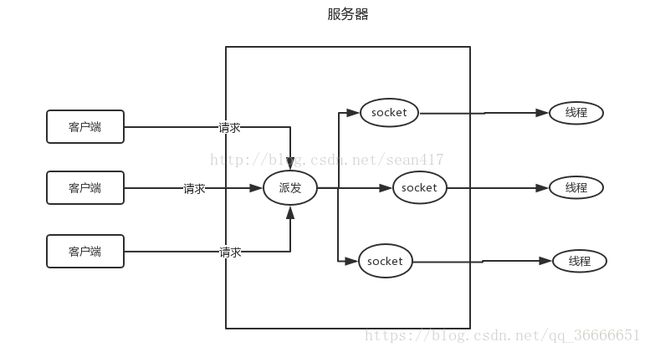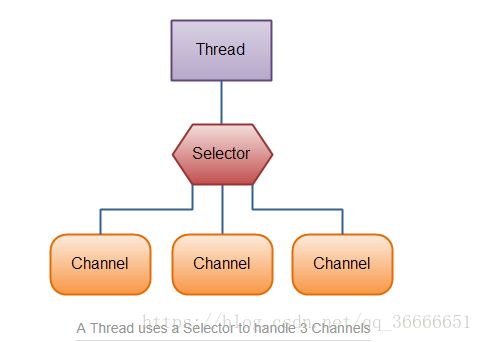java Nio 使用 NioSocket 客户端与服务端交互实现
NioSocket 客户端与服务端交互实现
java Nio是jdk1.4新增的io方式—–nio(new IO),这种方式在目前来说算不算new,更合适的解释应该是non-block IO。
non-block是相对于传统的io方式来讲的。传统的Io方式是阻塞的,我们拿网络io来举例,传统的io模型如下:

服务端主线程负责不断地server.accept(),如果没有客户端请求主线程就会阻塞,当客户端请求时,主线程会通过线程池创建一个新的线程执行。简单解释就是一个线程负责一个客户端的socket,当客户端因网络等原因传递速度慢的时候,服务端对应的客户端的线程就会等待,很浪费资源。同时线程过少的话会影响服务的吞吐量,而线程过多的话由于上下文切换等原因会导致效率十分低下,传统的io方式并不适合如今的网络流量。
Nio的模型如下:

nio相比传统的io模型,最大的特点是优化了线程的使用。nio通过selector可以使用一个线程去管理多个socket句柄,说是管理也不太合适,nio是采用的事件驱动模型,selector负责的是监控各个连接句柄的状态,不是去轮询每个句柄,而是在数据就绪后,将消息通知给selector,而具体的socket句柄管理则是采用多路复用的模型,交由操作系统来完成。selector充当的是一个消息的监听者,负责监听channel在其注册的事件,这样就可以通过一个线程完成了大量连接的管理,当注册的事件发生后,再调用相应线程进行处理。这样就不需要为每个连接都使用一个线程去维持长连接,减少了长连接的开销,同时减少了上下文的切换提高了系统的吞吐量。
java Nio的组成
java Nio主要由三个核心部分组成:
- Buffer
- Channel
- Selector
所有的io的Nio都是从一个channel开始的,Channel有点类似于流,但是和流不同的是,channel是可以双向读写的。Channel有几种类型,主要包含文件io操作和网络io:
- FileChannel (文件io)
- DatagramChannel (udp数据报)
- SocketChannel (tcp客户端)
- ServerSocketChannel (tcp服务端)
Buffer是一个中间缓存区,数据可以从channel读取到buffer,也可以从buffer写到channel中,在java中,传统方式与io的交互,需要将数据从堆内存读取到直接内存中,然后交由c语言来调用系统服务完成io的交互。而使用Buffer可以直接在直接内存中开辟内存区域,减少了io复制的操作,从而提高了io操作的效率。
#基本数据类型的buffer
- ByteBuffer
- CharBuffer
- DoubleBuffer
- FloatBuffer
- IntBuffer
- LongBuffer
- ShortBuffer
#文件内存映射buffer
- MappedByteBuffer
#直接内存区buffer
- DirectBuffer
Selector允许单个线程处理多个channel,可以将多个channel教给selector管理,并注册相应的事件,而selector则采用事件驱动的方式,当注册的事件就绪后,调用相应的相应的线程处理该时间,不用使用线程去维持长连接,减少了线程的开销。Selector通过静态工厂的open方法建立,然后通过channel的register注册到Channel上。注册后通过select方法等待请求,select请求有long类型参数,代表等待时间,如果等待时间内接受到操作请求,则返回可以操作请求的数量,否则超时往下走。传入参数为零或者无参方法,则会采用阻塞模式知道有相应请求。收到请求后调用selectedKeys返回SelectionKey的集合。SelectionKey保存了处理当前请求的Channel和Selector,并且提供了不同的操作类型。SelectionKey的操作有四种:
- SelectionKey.OP_CONNECT
- SelectionKey.OP_ACCEPT
- SelectionKey.OP_READ
- SelectionKey.OP_WRITE
下面为一个客户端与服务端实用NioSocket交互的简单例子:
//对selectionKey事件的处理
/**
* description:
*
* @author wkGui
*/
interface ServerHandlerBs {
void handleAccept(SelectionKey selectionKey) throws IOException;
String handleRead(SelectionKey selectionKey) throws IOException;
}
/**
* description:
*
* @author wkGui
*/
public class ServerHandlerImpl implements ServerHandlerBs {
private int bufferSize = 1024;
private String localCharset = "UTF-8";
public ServerHandlerImpl() {
}
public ServerHandlerImpl(int bufferSize) {
this(bufferSize, null);
}
public ServerHandlerImpl(String localCharset) {
this(-1, localCharset);
}
public ServerHandlerImpl(int bufferSize, String localCharset) {
this.bufferSize = bufferSize > 0 ? bufferSize : this.bufferSize;
this.localCharset = localCharset == null ? this.localCharset : localCharset;
}
@Override
public void handleAccept(SelectionKey selectionKey) throws IOException {
//获取channel
SocketChannel socketChannel = ((ServerSocketChannel) selectionKey.channel()).accept();
//非阻塞
socketChannel.configureBlocking(false);
//注册selector
socketChannel.register(selectionKey.selector(), SelectionKey.OP_READ, ByteBuffer.allocate(bufferSize));
System.out.println("建立请求......");
}
@Override
public String handleRead(SelectionKey selectionKey) throws IOException {
SocketChannel socketChannel = (SocketChannel) selectionKey.channel();
ByteBuffer buffer = (ByteBuffer) selectionKey.attachment();
String receivedStr = "";
if (socketChannel.read(buffer) == -1) {
//没读到内容关闭
socketChannel.shutdownOutput();
socketChannel.shutdownInput();
socketChannel.close();
System.out.println("连接断开......");
} else {
//将channel改为读取状态
buffer.flip();
//按照编码读取数据
receivedStr = Charset.forName(localCharset).newDecoder().decode(buffer).toString();
buffer.clear();
//返回数据给客户端
buffer = buffer.put(("received string : " + receivedStr).getBytes(localCharset));
//读取模式
buffer.flip();
socketChannel.write(buffer);
//注册selector 继续读取数据
socketChannel.register(selectionKey.selector(), SelectionKey.OP_READ, ByteBuffer.allocate(bufferSize));
}
return receivedStr;
}
}
//服务端server类
/**
* description:
*
* @author wkGui
*/
public class NioSocketServer {
private volatile byte flag = 1;
public void setFlag(byte flag) {
this.flag = flag;
}
public void start() {
//创建serverSocketChannel,监听8888端口
try (ServerSocketChannel serverSocketChannel = ServerSocketChannel.open()) {
serverSocketChannel.socket().bind(new InetSocketAddress(8888));
//设置为非阻塞模式
serverSocketChannel.configureBlocking(false);
//为serverChannel注册selector
Selector selector = Selector.open();
serverSocketChannel.register(selector, SelectionKey.OP_ACCEPT);
System.out.println("服务端开始工作:");
//创建消息处理器
ServerHandlerBs handler = new ServerHandlerImpl(1024);
while (flag == 1) {
selector.select();
System.out.println("开始处理请求 : ");
//获取selectionKeys并处理
Iterator keyIterator = selector.selectedKeys().iterator();
while (keyIterator.hasNext()) {
SelectionKey key = keyIterator.next();
try {
//连接请求
if (key.isAcceptable()) {
handler.handleAccept(key);
}
//读请求
if (key.isReadable()) {
System.out.println(handler.handleRead(key));
}
} catch (IOException e) {
e.printStackTrace();
}
//处理完后移除当前使用的key
keyIterator.remove();
}
System.out.println("完成请求处理。");
}
} catch (IOException e) {
e.printStackTrace();
}
}
}
//server端启动类
/**
* description:
*
* @author wkGui
*/
public class ServerMain {
public static void main(String[] args) {
NioSocketServer server = new NioSocketServer();
new Thread(() -> {
try {
Thread.sleep(10*60*1000);
} catch (InterruptedException e) {
e.printStackTrace();
}finally {
server.setFlag((byte) 0);
}
}).start();
server.start();
}
}
//客户端client类
/**
* description:
*
* @author wkGui
*/
public class NioSocketClient {
public void start() {
try (SocketChannel socketChannel = SocketChannel.open()) {
//连接服务端socket
SocketAddress socketAddress = new InetSocketAddress("localhost", 8888);
socketChannel.connect(socketAddress);
int sendCount = 0;
ByteBuffer buffer = ByteBuffer.allocate(1024);
//这里最好使用selector处理 这里只是为了写的简单
while (sendCount < 10) {
buffer.clear();
//向服务端发送消息
buffer.put(("current time : " + System.currentTimeMillis()).getBytes());
//读取模式
buffer.flip();
socketChannel.write(buffer);
buffer.clear();
//从服务端读取消息
int readLenth = socketChannel.read(buffer);
//读取模式
buffer.flip();
byte[] bytes = new byte[readLenth];
buffer.get(bytes);
System.out.println(new String(bytes, "UTF-8"));
buffer.clear();
sendCount++;
try {
Thread.sleep(1000);
} catch (InterruptedException e) {
e.printStackTrace();
}
}
} catch (IOException e) {
e.printStackTrace();
}
}
}
//client启动类
/**
* description:
*
* @author wkGui
*/
public class ClientMain {
public static void main(String[] args) {
new NioSocketClient().start();
}
}